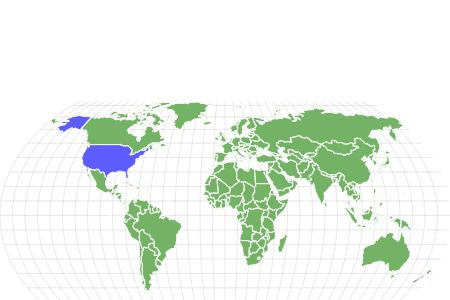Brontosaurus
Brontosaurus excelsus, Brontosaurus parvis, Brontosaurus yahnahpin
Their necks had air pockets that kept them light and relatively easy to maneuver.
Advertisement
Brontosaurus Scientific Classification
- Kingdom
- Animalia
- Phylum
- Chordata
- Family
- Diplodocidae
- Genus
- Brontosaurus
- Scientific Name
- Brontosaurus excelsus, Brontosaurus parvis, Brontosaurus yahnahpin
Brontosaurus Facts
- Fun Fact
- Their necks had air pockets that kept them light and relatively easy to maneuver.
- Most Distinctive Feature
- Long neck
- Distinctive Feature
- Small head
View all of the Brontosaurus images!
If you ever did a school report on dinosaurs, or watched the movie Jurassic Park, then you know the famous long-necked Brontosaurus.
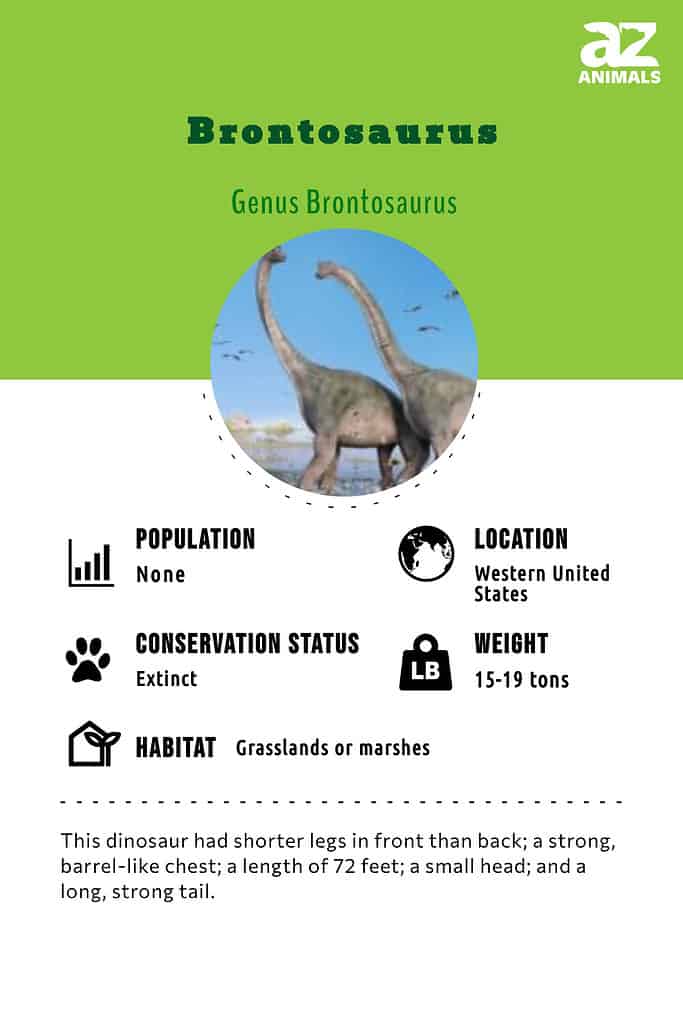
This giant dinosaur roamed the earth during the late Jurassic Period, between 145.5 and 196.6 million years ago, in what is now the western United States. There are actually three species of Brontosaurus dinosaurs of varying sizes. All are gigantic compared to modern-day animals. Learn more about this gentle giant, including what it looked like, what it ate, and what made it disappear.
Brontosaurus Species, Types, and Scientific Name
Brontosaurus is a genus in the Diplodocidae family. It was once believed to be a type of Apatosaurus, leading to its inclusion in the Apatosaurinae sub-family. Scientists now classify it as its own genus, which includes three species: B. excelsus, B. parvis, and B. yahnahpin.
These dinosaurs are part of the Sauropoda clade, which includes dinosaurs that walked on all fours with long necks, long tails, and small heads. Brontosaurus is a great example of this type of dinosaur.
Brontosaurus
| Kingdom | Animalia |
| Phylum | Chordata |
| Clade | Sauropoda |
| Family | Diplodocidae |
| Sub-Family | Apatosaurinae |
| Genus | Brontosaurus |
| Species | Brontosaurus excelsus, Brontosaurus parvis, Brontosaurus yahnahpin |
Description and Size
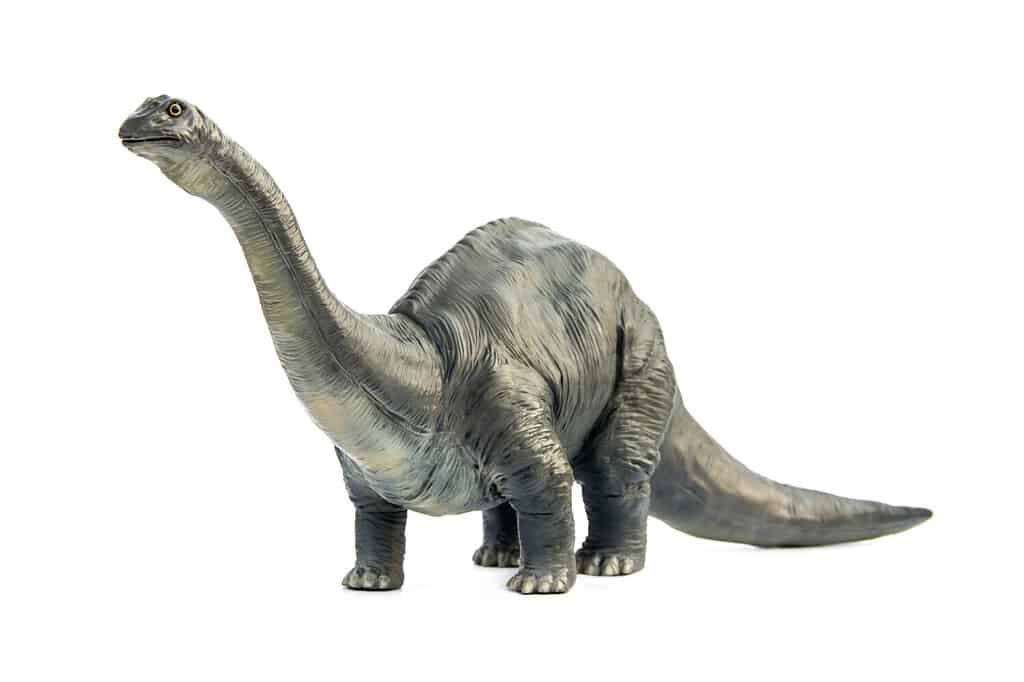
Brontosaurus weighed an average of 15-19 tons.
©Ton Bangkeaw/Shutterstock.com
These giant dinosaurs were some of the largest that walked the earth during the Jurassic Period. The Brontosaurus measured up to 72 feet from the top of their heads to the tip of their tails. Because they walked on all fours, this long length didn’t mean that they were that tall when they walked. B. excelsus is the largest of the three known species, although all were very big. They weighed, on average, 15-19 tons, but could weigh up to 25 tons!
The Brontosaurus had a small head, especially considering the very long size of its body. Although paleontologists have yet to find an intact skull to be sure, they estimate that a Brontosaurus’s head was similar to the Apatosaurus based on fossils of its vertebrae and neck. To support their heads and long necks, they had very strong vertebrae and neck muscles. Their necks also had air pockets that kept them light and relatively easy to maneuver.
These dinosaurs also had long, strong tails. They could whip them around to defend themselves from predators. Their tails were more slender than some other Sauropods but still had the whip at the end. Brontosaurus had a strong, barrel-like chest. Their front legs were slightly shorter than their hind legs, likely to help them balance the weight of their neck and tail.
Diet
Given their enormous size, you may think that Brontosaurus ate meat to help sustain all of that muscle. But these giant dinosaurs were herbivores, like other Sauropods. They likely ate plants and vegetation that were hard to reach. Many Sauropods evolved with long necks to help with feeding.
Amazingly, Brontosauruses also ate rocks. While they didn’t get any nutritional value from this food, it did help break up the plant matter in their stomachs. This helped them get the most nutrients they could out of their diet. Brontosaurus likely had to eat a lot to maintain their size.
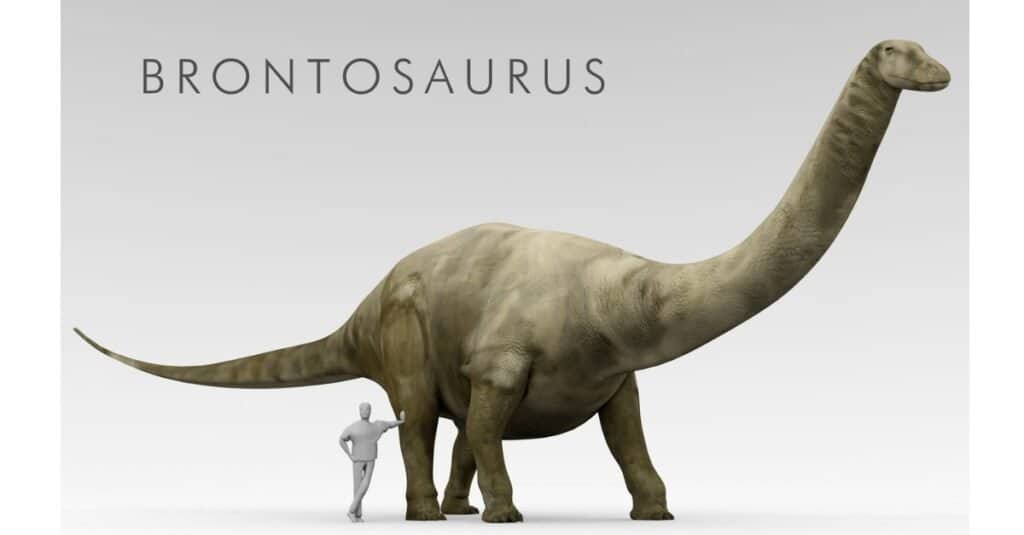
A comparison between a Human and a Brontosaurus.
©iStock.com/Aunt_Spray
Habitat
Scientists use fossil location to determine both where and when dinosaurs lived. Based on analysis of the surrounding rock, they can pinpoint the time period. The location of the discovery and what they know about the shifting of the earth during prehistoric periods help them know more about the type of landscape and where it lived.
Brontosaurus lived in the western United States. Many specimens were found in the large rock formation, Morrison Formation, that spans from Montana to New Mexico. Brontosaurus fossils discovered here show that these dinosaurs lived during the late Jurassic Period. This was around 157-145 million years ago.
Fossils that definitely belonged to Brontosaurus were found in Wyoming, one of the sites where scientists agree Brontosaurus lived millions of years ago. Due to their diet, researchers believe that they lived in grasslands or marshes that had plenty of vegetation for them to eat.
Threats And Predators
Even though they were herbivores and did not prey on other dinosaurs, they most probably still left the gigantic Brontosaurus alone. Their tails could whip around to fend off smaller carnivorous dinosaurs. Their large size was also a deterrent, as it would take multiple carnivores to take down just one Brontosaurus. Most carnivorous dinosaurs during the Late Jurassic were solitary hunters and couldn’t prey on the Brontosaurus.
Illness and injury were always threats for dinosaurs and the Brontosaurus was no exception. Because they had to eat so much to maintain their size, competition for resources may have been a very real threat for these dinosaurs.
Brontosaurus young hatched from eggs. At one point, when paleontologists believed that Sauropods lived in water, they thought that Brontosaurus gave birth to live babies. Now, they know otherwise.
Discoveries and Fossils
The drama of the Brontosaurus’s discovery and classification is unique in the dinosaur world. Paleontologist Othniel Charles Marsh found a Brontosaurus fossil in 1874 in the Morrison Formation. While he was understandably excited about his new discovery, classifying it as a Brontosaurus in 1879, Marsh was in competition with another notable paleontologist of the time.
Elmer Riggs believed that the Brontosaurus was actually a younger version of the Apatosaurus, which he had discovered and classified in 1877. The Brontosaurus had been quite well-known in popular culture and museums up to that point. But when it became absorbed by the already-classified Apatosaurus genus, controversy ensued. Because the public knew the same Brontosaurus much more, many Apatosaurus were actually called Brontosaurus. The two names became synonyms, although the scientific classification was Apatosaurus.
It wasn’t until the late 1970s that researchers took a closer look at the many collected specimens, comparing measurements and sizes to see if they should actually be two distinct genera. Indeed, now the Brontosaurus and the Apatosaurus are two genera of dinosaurs, although they do share many features.
Major discoveries and fossils of Brontosaurus are in the Morrison Formation. There have been so many dinosaur fossils discovered there, many from the Jurassic Period, that the National Park Service created the Dinosaur National Monument. Visitors can see fossils still in the ground and scientists can continue excavating to learn more about these giant creatures.
Extinction
All of the known Brontosaurus fossils are dated to the Jurassic Period. There is no evidence of these dinosaurs after around 145 million years ago. Therefore, researchers believe that the Brontosaurus went extinct by the end of the Jurassic Period.
Scientists do not know exactly why the Brontosaurus went extinct, just that there is no evidence of it after the Jurassic concluded. Competition over food and resources, changing climate, or increased predators may have all played a role in the extinction of these giant animals.
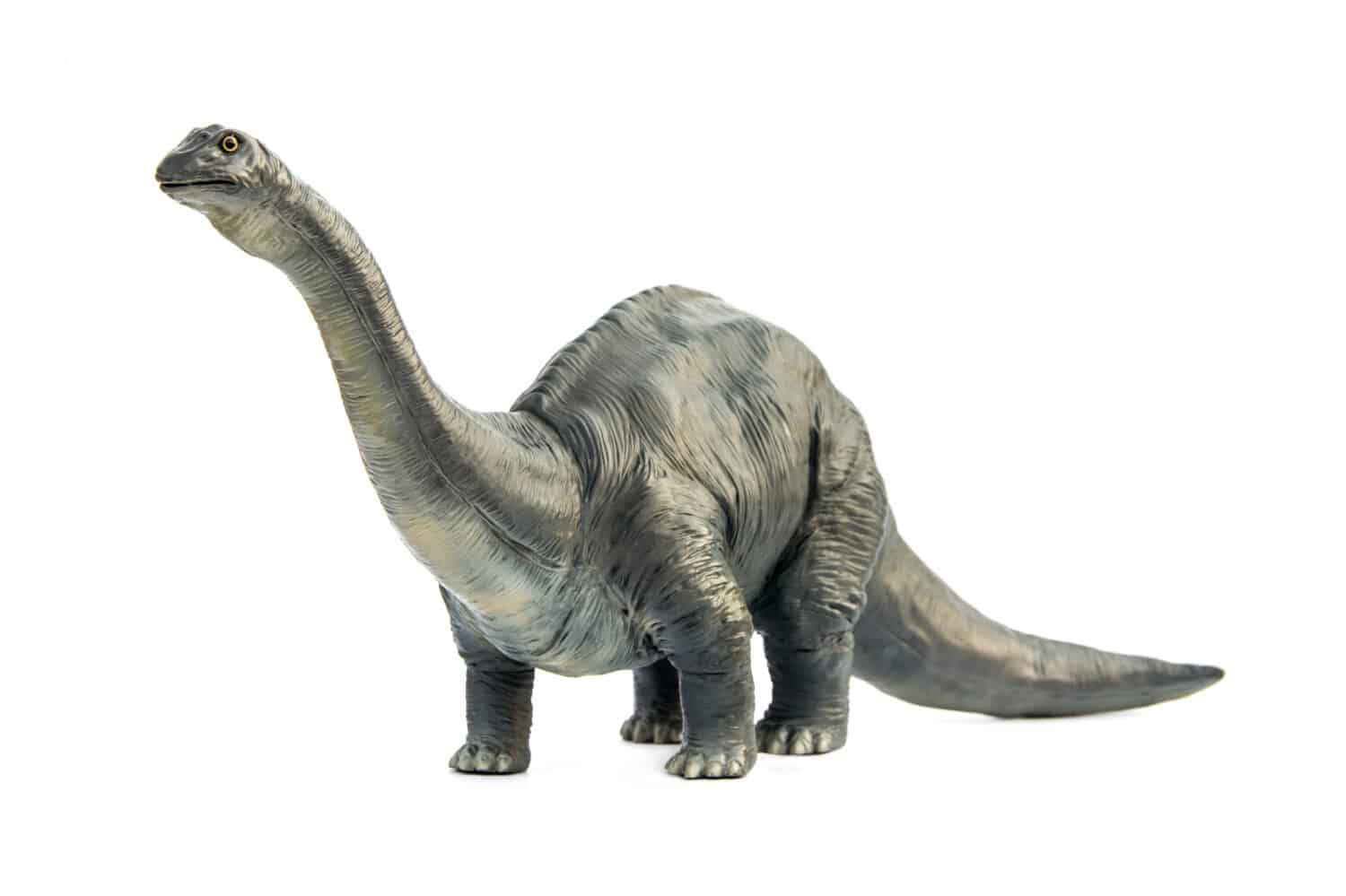
Image: Ton Bangkeaw, Shutterstock
©Ton Bangkeaw/Shutterstock.com
Similar Animals
While the Brontosaurus is one of the most well-known Sauropods in pop culture, there are many other species that are similar. Some, such as the Apatosaurus, are so similar that scientists believed for almost a century that they were the same dinosaur.
- Apatosaurus: These Sauropods are very similar to Brontosaurus, with the same habitat, eating habits, and overall body structure. They were much larger, however, and had slightly different skulls.
- Diplodocus: These giant dinosaurs were probably smaller than the Brontosaurus. They had similar body shapes, although the Diplodocus tail was longer. It also had a more slender neck.
- Brachiosaurus: The Brachiosaurus’ neck was much longer, relative to the rest of its body. Their front legs were also much longer, leading to them being known as an “arm lizard.”
Brontosaurus FAQs (Frequently Asked Questions)
When did Brontosaurus live?
Brontosaurus lived during the Late Jurassic Period and probably went extinct around 145 million years ago. During this time, many other Sauropods also lived. These dinosaurs walked on all fours and had long tails and necks.
How big was a Brontosaurus?
Brontosaurus weighed 15-19 tons on average but could weight up to 25 tons and be over 70 feet long from their head to the tip of their tail.
Are a Brontosaurus and an Apatosaurus the same dinosaur?
The Brontosaurus and Apatosaurus are two distinct genera of Sauropod dinosaurs. However, for almost a century, scientists believed that they were the same type of dinosaur. They were scientifically classified as Apatosaurus, although often referred to as Brontosaurus due to that name being better recognized. Now, researchers classify and refer to them separately.
Thank you for reading! Have some feedback for us? Contact the AZ Animals editorial team.
Sources
- Encyclopedia Britannica, Brontosaurus, Available here: https://www.britannica.com/animal/Brontosaurus
- NPS: Morrison Formation, Available here: https://www.nps.gov/dino/learn/nature/morrison-formation.htm
- Smithsonian Magazine, Brontosaurus Returns, Available here: https://www.smithsonianmag.com/science-nature/brontosaurus-returns-112932715/#:~:text=Instead%20of%20laying%20clutches%20of,20th%20century%20paleontologists%20actually%20considered.

